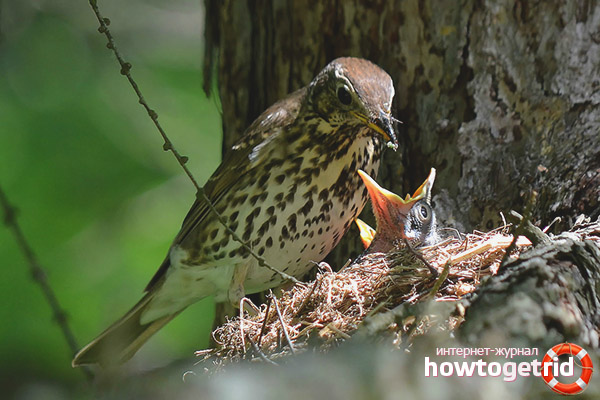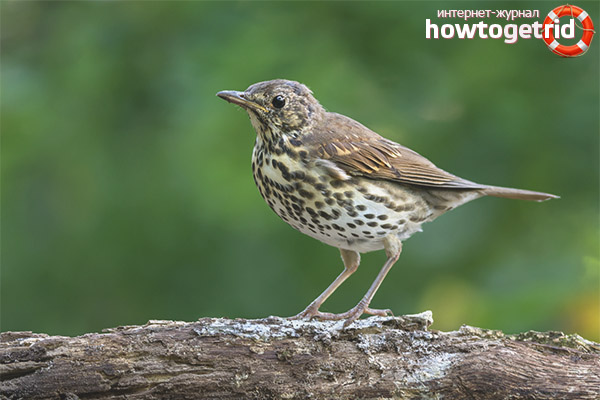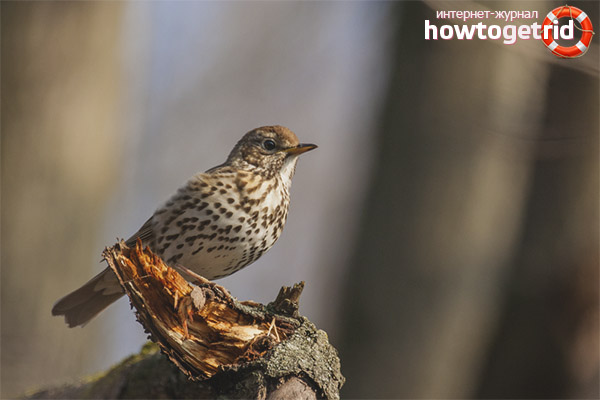The content of the article
Songbird - a small bird belonging to the family of passerines, as a rule, birds of this species keep alone or gather in small flocks. The main diet of thrushes is small insects, worms, seeds and a variety of berries. The average life expectancy of representatives of this species is 14-15 years.
These birds are most common in Europe. This species willingly settles in new territories, so often the song thrush can be found in urban park areas and gardens.
Behavior features
The main nesting place for such birds of the thrush family is the territories located in the northern and central parts of Europe, as well as western Siberia. Eastern and northern bird colonies migrate to warmer climes during the winter.
In the air, the songbird keeps straight, looking closely you can see the inside of the wing with a characteristic ocher color, which, in fact, this view differs from waxwings.
The feather cover of the bird has a rather modest coloration: the back is brownish, the abdomen is white, the upper tail is gray, with a border.
The length of the legs of the songbird is quite large in contrast to similar species, which is why the bird walks directly. Feathered birds find food mainly on the surface, covering quite large distances, jumping or running. During stops, the thrush often tilts its small head to one side, making the bird seem to be listening to something. In fact, he inspects the food area in search of food, which is caused by the lateral arrangement of the eyes.
The voice of the bird
Lifestyle
The main habitat of songbirds are forests of any type (deciduous, coniferous, mixed). Often these birds settle near agricultural land, quickly getting used to the constant presence of man. In mountainous regions, representatives of this species of birds are extremely rare, nesting no higher than the upper part of the forest border.
Song thrushes, which lives in the central part of Europe, are migratory species, and, as a rule, return to their nesting place with the onset of the first warm days (end, February, beginning of March).
Power Features

Songbirds are unpretentious birds in their diet, eating a wide variety of feeds. The diet of these birds depends on some factors - the nesting place, season, as well as climatic conditions. The main food for birds in early spring are mainly earthworms. Then caterpillars, snails, spiders, small beetles are added to the diet. In the summer, these birds consume plant seeds, small fruits, and berries more for food - this helps the thrush to stock up with the necessary energy for a quick flight to the warm regions during the winter.
Propagation Features
Song of the song thrush is not only a favorite pastime of this bird, but also a great way to attract females and mark the boundaries of their own territory.
Encountering his rival, the thrush, as a rule, extends its neck forward, grouches its plumage and spreads its tail, which should frighten the competitor.Before the female, the thrush performs a peculiar dance - running from one side to the other, folding and unfolding its fan-shaped tail.
For nesting birds choose mainly dense thickets of shrubs or areas with densely arranged tall trees, placing the nest at a height of several meters from the surface of the earth. The very shape of the nest itself is cup-shaped, the birds build their house from branches, vegetation and moss, clay with pieces of branches and stools of animals is used to strengthen the structure.
The number of eggs in the clutch does not exceed 5 pieces. The female hatches the future offspring on their own (the duration of the incubation period is about 14 days). The chicks that were born stand on the wing after 2 weeks.
Interesting Facts
Today, only six species of birds of the thrush family live in the territory of European countries, including the song thrush, which is very similar to such a species as the waxwing. It differs from it by its characteristic white bordering on the plumage of the tail and wings.
A song performed by a songbird is very easy to distinguish from sounds made by other species of birds. As a rule, thrushes of thrushes harmoniously intertwine with the singing of other songbirds, representatives of this species usually perform their intricate trills, comfortably sitting on top of shrubs or tall trees. This species also has its favorite tunes, which the individual periodically repeats.
Note that the singing repertoire of some birds of this species is so vast that the same motive can be repeated only after a few dozen musical phrases, which is why these birds are called forest nightingales.
Often, birds organize serious battles in their fodder territories, figuring out who gets the most delicious food or its larger quantity.
This species of birds like thrushes acclimatized well in Australia after it was introduced there. After that, these birds appeared in New Zealand.
At present, the populations of songbirds are not at risk, this is due to the sufficient distribution of this species throughout Europe and its excellent ability to adapt, spread to new territories.
Video: songbird (Turdus philomelos)











Submit